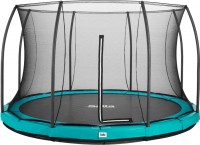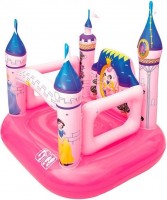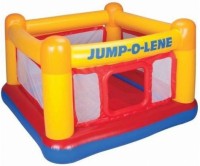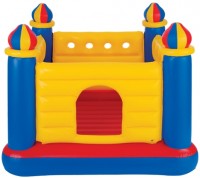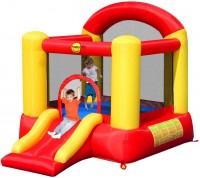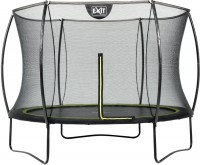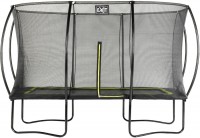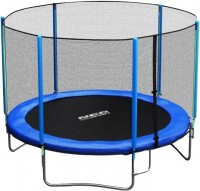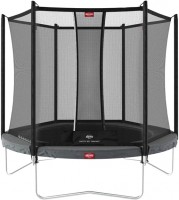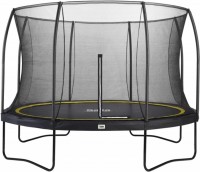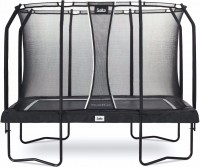Trampolines Salta
All Trampolines Advanced filters → |
You might be interested in
Trampolines: specifications, types
Type
— Frame. Classic design: this trampoline is based on a durable fabric stretched over a spring frame. Trampolines of this type are simple in design, relatively inexpensive, and can be disassembled to a very compact state. They are suitable for both children and adults. On the other hand, the mentioned simplicity of design limits the features for games and specific training available on such a device.
— At ground level. Trampolines designed to be installed directly on the ground, and in some models even to be dug into it. Such trampolines are safer and more reliable than classic models with legs — in fact, there are no legs in the design, which means that there is no risk that one of them will break at the wrong moment. On the other hand, under such a product there must be a recess of a certain size (the size is indicated by the manufacturer in the detailed specifications) — which means that during installation, most likely, you will have to dig the ground.
— Inflatable. Trampoline in the form of an inflatable shell; however, in most models, the pressure is maintained by a constantly running compressor. The surface of such a shell is inferior in elasticity to the fabric of a frame trampoline, does not allow high jumps and is less able to withstand high loads. On the other hand, an inflatable product can be given a complex shape — for example, it can be m...ade in the form of a fairy-tale castle or a whole play complex with "houses", slides, labyrinths, etc. As a result of all this, mainly trampolines for children, intended for entertainment, are made inflatable.
— For fitness. Trampolines designed primarily for jumping fitness — cardio training using an elastic surface. They have a small diameter (most often up to 1.5 m), are designed for one person and are often equipped with a handle for support (see "Complete set"). Note that such models are poorly suited for aerial acrobatics, they are designed mainly for low jumps and running in place.
— At ground level. Trampolines designed to be installed directly on the ground, and in some models even to be dug into it. Such trampolines are safer and more reliable than classic models with legs — in fact, there are no legs in the design, which means that there is no risk that one of them will break at the wrong moment. On the other hand, under such a product there must be a recess of a certain size (the size is indicated by the manufacturer in the detailed specifications) — which means that during installation, most likely, you will have to dig the ground.
— Inflatable. Trampoline in the form of an inflatable shell; however, in most models, the pressure is maintained by a constantly running compressor. The surface of such a shell is inferior in elasticity to the fabric of a frame trampoline, does not allow high jumps and is less able to withstand high loads. On the other hand, an inflatable product can be given a complex shape — for example, it can be m...ade in the form of a fairy-tale castle or a whole play complex with "houses", slides, labyrinths, etc. As a result of all this, mainly trampolines for children, intended for entertainment, are made inflatable.
— For fitness. Trampolines designed primarily for jumping fitness — cardio training using an elastic surface. They have a small diameter (most often up to 1.5 m), are designed for one person and are often equipped with a handle for support (see "Complete set"). Note that such models are poorly suited for aerial acrobatics, they are designed mainly for low jumps and running in place.
Shape
Trampoline surface shape.
— Round. The traditional form, which is still considered one of the most optimal and convenient options for frame and fitness trampolines (see "Type"). So, the circle has the smallest frame length with the same area (which reduces the cost of the product); and the person jumping in the centre is at the same distance from any point on the edge, which contributes to safety.
— Oval. A modification of the round trampolines described above, which has a slightly elongated shape. This form allows you to comfortably accommodate two or even more people on the trampoline; oval products are most often multi-seat and have a corresponding maximum load (see below).
— Rectangular. The rectangular shape, for technical reasons, is considered poorly suited for frame-type trampolines (see above). Therefore, the vast majority of such models are inflatable, and in this case we are talking exclusively about the shape of the base — the superstructure over this base can be very intricate.
— Square. Square trampolines are completely similar to the rectangular ones described above, with the exception of the actual shape of the base: it has the same (or almost the same) size in length and width.
— Hexagonal. An option that is generally similar to the round one described above. At the...same time, a polygonal design is simpler and cheaper than a round one, and it is also easier to make such a base disassembled to simplify storage and transportation. On the other hand, the polygonal base is somewhat inferior to the round base in terms of reliability (with the same material and thickness of the frame), which makes it difficult to create large trampolines with a high allowable load. Because of this, this variant is found mainly among fitness models (see "Type").
— Octagonal. Another version of the polygonal frame, in many respects similar to the hexagonal one (see above), but more durable and reliable, and therefore used mainly in fairly large frame trampolines.
— Round. The traditional form, which is still considered one of the most optimal and convenient options for frame and fitness trampolines (see "Type"). So, the circle has the smallest frame length with the same area (which reduces the cost of the product); and the person jumping in the centre is at the same distance from any point on the edge, which contributes to safety.
— Oval. A modification of the round trampolines described above, which has a slightly elongated shape. This form allows you to comfortably accommodate two or even more people on the trampoline; oval products are most often multi-seat and have a corresponding maximum load (see below).
— Rectangular. The rectangular shape, for technical reasons, is considered poorly suited for frame-type trampolines (see above). Therefore, the vast majority of such models are inflatable, and in this case we are talking exclusively about the shape of the base — the superstructure over this base can be very intricate.
— Square. Square trampolines are completely similar to the rectangular ones described above, with the exception of the actual shape of the base: it has the same (or almost the same) size in length and width.
— Hexagonal. An option that is generally similar to the round one described above. At the...same time, a polygonal design is simpler and cheaper than a round one, and it is also easier to make such a base disassembled to simplify storage and transportation. On the other hand, the polygonal base is somewhat inferior to the round base in terms of reliability (with the same material and thickness of the frame), which makes it difficult to create large trampolines with a high allowable load. Because of this, this variant is found mainly among fitness models (see "Type").
— Octagonal. Another version of the polygonal frame, in many respects similar to the hexagonal one (see above), but more durable and reliable, and therefore used mainly in fairly large frame trampolines.
Net
The type of safety net provided in the design of the trampoline.
For details on the grids themselves, see "Packaging", and their types can be as follows:
- External. Mesh stretched over supports from the outside. This design leaves the maximum possible area of the trampoline open, but requires care so that the jumper does not hit the stand or step on the cape covering the springs. Therefore, this option is recommended primarily for adults, more or less experienced users.
- Internal. Mesh stretched over supports from the inside. With the same dimensions of the trampoline, it leaves less free space than the outer one. At the same time, the net supports and the springs of the trampoline itself remain behind the fence, and the risk of an unpleasant collision with them is minimal. Therefore, for children, especially small ones, it is internal nets that are recommended.
For details on the grids themselves, see "Packaging", and their types can be as follows:
- External. Mesh stretched over supports from the outside. This design leaves the maximum possible area of the trampoline open, but requires care so that the jumper does not hit the stand or step on the cape covering the springs. Therefore, this option is recommended primarily for adults, more or less experienced users.
- Internal. Mesh stretched over supports from the inside. With the same dimensions of the trampoline, it leaves less free space than the outer one. At the same time, the net supports and the springs of the trampoline itself remain behind the fence, and the risk of an unpleasant collision with them is minimal. Therefore, for children, especially small ones, it is internal nets that are recommended.
Maximum weight
The greatest load that a trampoline is designed for, in other words, the total weight of people that it is able to transfer without consequences. This parameter is one of the main when choosing a trampoline. In no case should you exceed the maximum load, this is fraught with equipment breakdowns and serious injuries to athletes (moreover, such a nuisance can occur after exposure to an abnormal load, under a completely permissible weight). Accordingly, when choosing, it is worthwhile to clearly determine the maximum load that the product can be subjected to.
High maximum load values are especially important when installed in trampoline centers, gyms and other public places where the circle of potential athletes is unlimited, and among them there may be people of a very large build.
High maximum load values are especially important when installed in trampoline centers, gyms and other public places where the circle of potential athletes is unlimited, and among them there may be people of a very large build.
Test weight
The static test weight of a trampoline is the weight of the load that the product can safely support if this load is carefully, without shaking, placed on the canvas; in other words, the absolute maximum load allowed for this model.
The test weight is usually several times greater than the maximum load (see above). This is due to the fact that during jumps, the impact force is much higher than the weight of the person jumping directly: after all, a person falls onto the canvas from a height. It is believed that the test weight should be at least 4 times the maximum load — only in this case can we talk about the safe use of a trampoline. But the ratio can be even more impressive, and the higher it is, the more reliable and durable the design: for example, a trampoline with a test weight of 600 kg and a load capacity of 120 kg will be more durable than a model of 500 and 120 kg, respectively. So this indicator makes it possible to compare different models in terms of overall quality.
The test weight is usually several times greater than the maximum load (see above). This is due to the fact that during jumps, the impact force is much higher than the weight of the person jumping directly: after all, a person falls onto the canvas from a height. It is believed that the test weight should be at least 4 times the maximum load — only in this case can we talk about the safe use of a trampoline. But the ratio can be even more impressive, and the higher it is, the more reliable and durable the design: for example, a trampoline with a test weight of 600 kg and a load capacity of 120 kg will be more durable than a model of 500 and 120 kg, respectively. So this indicator makes it possible to compare different models in terms of overall quality.
Trampoline size (LxWxH)
The overall size of the trampoline; in this case, the height can be measured both by the height of the working surface, without taking into account the protective grid and other additional devices, and by the overall dimensions of the product in the working position. Also note that the size of the working area on the canvas is usually less than the overall dimensions in length and width — there is protection along the edges that covers the springs, and it is undesirable to jump on it.
Mesh height
The height of the regular trampoline protective net (see "Complete set"). This height is usually measured from the working surface, which allows you to evaluate the protective properties of the mesh. The higher it is, the better, but in general it is desirable that the height is not lower than the height of the intended user (or at least slightly lower).
Number of springs
The number of springs provided in the design of the trampoline of the corresponding type (see above).
The smaller the springs, the larger and thicker each of them must be in order to normally carry their “portion” of the load. However manufacturers usually choose the thickness and quantity in such a way as to achieve the required performance. Therefore, from the user's point of view, there is no key difference between an abundance of small springs and a few large ones, and this parameter, in fact, is purely reference.
The smaller the springs, the larger and thicker each of them must be in order to normally carry their “portion” of the load. However manufacturers usually choose the thickness and quantity in such a way as to achieve the required performance. Therefore, from the user's point of view, there is no key difference between an abundance of small springs and a few large ones, and this parameter, in fact, is purely reference.
In box
— Protective mesh. A rather high net, stretched around the perimeter of the trampoline and designed to prevent falling over its edge, which is fraught with injuries. Note that such a device is not a 100% guarantee and does not eliminate the need to be careful. However, it markedly reduces the chance of "going overboard"; and if the product is purchased for children, the presence of a net in the kit is highly desirable. However, if necessary, the trampoline can be used without it.
— Handle for support. A handle that a person on a trampoline can hold on to while jumping. This feature is quite popular in fitness models (see "Type"), it makes it easier to perform some specific exercises. Also, the pen can be useful for novice users who do not have the skill of jumping on a trampoline — as an additional insurance.
— Staircase. A small ladder that facilitates the ascent to the working surface of the trampoline. Such a surface can be located at a height of several tens of centimeters, which can create serious inconvenience for some users (for example, children). Of course, for the convenience of lifting, you can also use improvised devices (for example, build "steps" from a pair of boxes of different heights), but a complete ladder is usually more convenient, more compact, and often safer.
— Gorka. A classic slopi...ng slide that kids can slide down while playing. It is found exclusively in inflatable models (see "Type"), in other types of trampolines, it is not only technically difficult to provide such a feature, but it is generally pointless. And some slides are made "water" — they can be poured with water from nozzles built right into the trampoline, which is indispensable for playing on a hot summer day.
— Water effect. Possibility to water the trampoline. This possibility is provided only in inflatable models (see "Type"). Such products are used not so much as trampolines as such, but as entertainment structures; they have a jump zone, but, in addition to it, the design usually provides for a slide, and other devices can also be used — for example, a water cannon for games, a shallow “splash pool”, etc. A special nozzle in the upper part is usually responsible for supplying water, which plays the role of a “shower” (including for players). The water effect performs two functions: firstly, it refreshes in hot weather, and secondly, it makes the trampoline is more slippery (this is true for downhill slides.).
— Air blower. The air blower is a very important piece of equipment for many inflatable trampolines (see "Type"): during operation, they maintain pressure in the shell. At the same time, we note that, unlike many inflatable structures, trampolines with superchargers are not hermetic: air is constantly supplied from the compressor and bled through the outlet. This provides the necessary elasticity and at the same time protects the shell from sudden pressure drops (especially when jumping), reducing the likelihood of damage: excess air simply fly out. The absence of a supercharger in an inflatable trampoline kit, usually, means that we have before us the simplest model for the smallest children, often not designed for jumping at all.
— Repair kit .. Kit for repairing damage to the inflatable shell in a trampoline of the corresponding type (see above). The main element of such a kit are patches that can be self-adhesive or attached using the composition supplied in the kit. Other elements may also be included in the set. However, anyway, using such a kit for repair is more convenient and reliable than using a “non-native” one: the standard kit is optimally suited for a specific shell.
— Tools. Tools can be completed with frame trampolines and models for fitness (see "Type"). Such products are usually disassembled for storage and transportation, and must be assembled before use. To do this, tools are provided in the kit — usually, the simplest ones, such as wrenches for standard nut sizes used in the design. Despite their simplicity, such devices are optimally suited for this product and may be more convenient than third-party tools; and if the latter are absent nearby, this feature turns out to be indispensable in general.
— Case. Case designed for storage and transportation of the trampoline. Protects the product from dust, dirt, moisture and other adverse effects, as well as from unwanted contact with surrounding objects. For these purposes, you can use third-party cases, including self-made, however, a complete case, usually, is more convenient and reliable.
— Handle for support. A handle that a person on a trampoline can hold on to while jumping. This feature is quite popular in fitness models (see "Type"), it makes it easier to perform some specific exercises. Also, the pen can be useful for novice users who do not have the skill of jumping on a trampoline — as an additional insurance.
— Staircase. A small ladder that facilitates the ascent to the working surface of the trampoline. Such a surface can be located at a height of several tens of centimeters, which can create serious inconvenience for some users (for example, children). Of course, for the convenience of lifting, you can also use improvised devices (for example, build "steps" from a pair of boxes of different heights), but a complete ladder is usually more convenient, more compact, and often safer.
— Gorka. A classic slopi...ng slide that kids can slide down while playing. It is found exclusively in inflatable models (see "Type"), in other types of trampolines, it is not only technically difficult to provide such a feature, but it is generally pointless. And some slides are made "water" — they can be poured with water from nozzles built right into the trampoline, which is indispensable for playing on a hot summer day.
— Water effect. Possibility to water the trampoline. This possibility is provided only in inflatable models (see "Type"). Such products are used not so much as trampolines as such, but as entertainment structures; they have a jump zone, but, in addition to it, the design usually provides for a slide, and other devices can also be used — for example, a water cannon for games, a shallow “splash pool”, etc. A special nozzle in the upper part is usually responsible for supplying water, which plays the role of a “shower” (including for players). The water effect performs two functions: firstly, it refreshes in hot weather, and secondly, it makes the trampoline is more slippery (this is true for downhill slides.).
— Air blower. The air blower is a very important piece of equipment for many inflatable trampolines (see "Type"): during operation, they maintain pressure in the shell. At the same time, we note that, unlike many inflatable structures, trampolines with superchargers are not hermetic: air is constantly supplied from the compressor and bled through the outlet. This provides the necessary elasticity and at the same time protects the shell from sudden pressure drops (especially when jumping), reducing the likelihood of damage: excess air simply fly out. The absence of a supercharger in an inflatable trampoline kit, usually, means that we have before us the simplest model for the smallest children, often not designed for jumping at all.
— Repair kit .. Kit for repairing damage to the inflatable shell in a trampoline of the corresponding type (see above). The main element of such a kit are patches that can be self-adhesive or attached using the composition supplied in the kit. Other elements may also be included in the set. However, anyway, using such a kit for repair is more convenient and reliable than using a “non-native” one: the standard kit is optimally suited for a specific shell.
— Tools. Tools can be completed with frame trampolines and models for fitness (see "Type"). Such products are usually disassembled for storage and transportation, and must be assembled before use. To do this, tools are provided in the kit — usually, the simplest ones, such as wrenches for standard nut sizes used in the design. Despite their simplicity, such devices are optimally suited for this product and may be more convenient than third-party tools; and if the latter are absent nearby, this feature turns out to be indispensable in general.
— Case. Case designed for storage and transportation of the trampoline. Protects the product from dust, dirt, moisture and other adverse effects, as well as from unwanted contact with surrounding objects. For these purposes, you can use third-party cases, including self-made, however, a complete case, usually, is more convenient and reliable.

